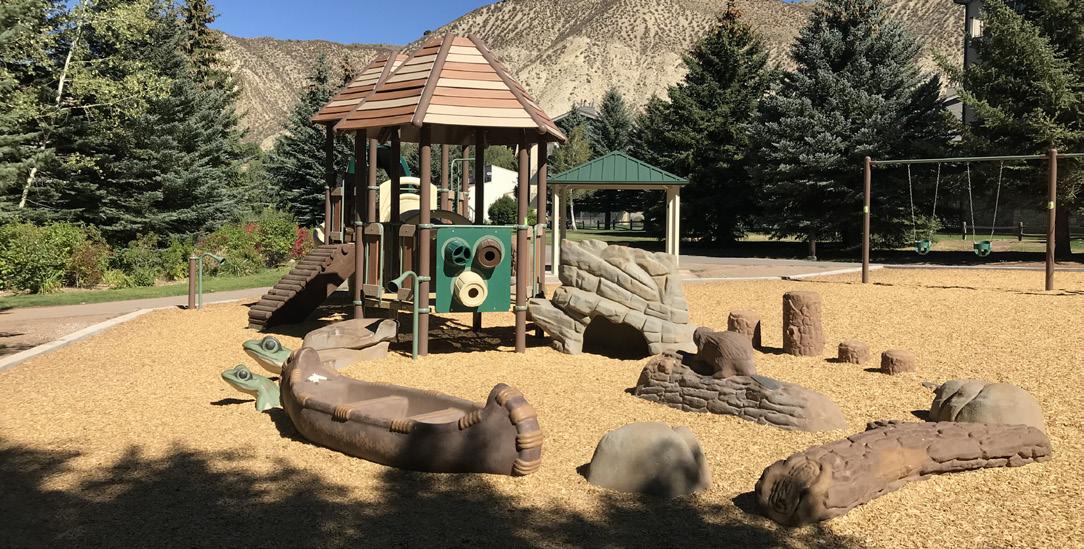
23 minute read
Churchich Recreation – churchichrecreation.net
some of the best government professionals can share their knowledge and experiences. Most of the classes are taught by current or former City Managers and other high level government leaders. Many participants in the CPM program are tenured professionals with several years of government experience. This program pushed me well outside of my comfort zone, as I was one of the least experienced participants. This opportunity exposed me to some of the great personalities and thought processes of local government leaders. It inspired me to sharpen and practice the skills I have learned and strive for continuous improvement. The experience from this program energized me in a new way and made me realize I still have much to learn. I will never stop learning. The CPM program can be utilized as 6 credit hours towards a Master’s degree in Public Administration (MPA), which inspired me to keep pushing and enroll to complete my MPA. I have found it very useful to stay curious and follow the things that give me energy. Ask yourself, what excites you and gives you energy in your professional life? How can you deepen and improve that thing? Find any opportunity you can to pursue the things that energize you! Professional development is not a lone journey. It requires a commitment to yourself and those you are striving to help. It also requires support from those closest to you. This might be one of the best parts of the journey, discovering how many people support your aspirations and believe in you. From a partner, a friend, a family member, to mentors, supervisors, or scholarship provider, there are so many people who believe in you and want to see you succeed. I am one of those people, and ready to help you continue or start your journey. Please feel free to connect with me through CPRA’s new Connected Communities if I can be of any assistance or support. Just ask yourself what you want, how you will get there, and then take a step. You won’t regret it, I guarantee it.
building colorado parks for over 45 years: Consulting & Design Services for Parks & Playgrounds Playground Equipment & Safety Surfacing Outdoor Fitness for Teens & Adults Shade Shelters & Landscape Furnishings

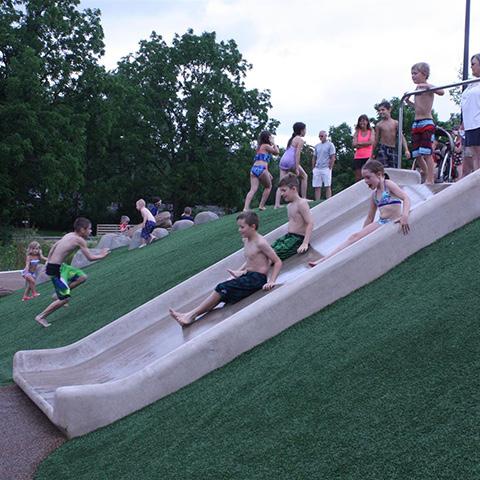
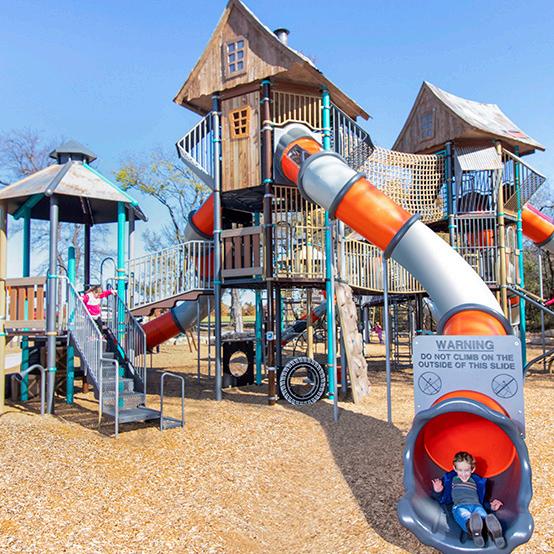



www.churchichrecreation.net
sales@churchichrecreation.net 303-530-4414

RECREATION REBOOT

Stories of ingenuity as Colorado agencies adapt and reinvent to overcome COVID-19 hurdles
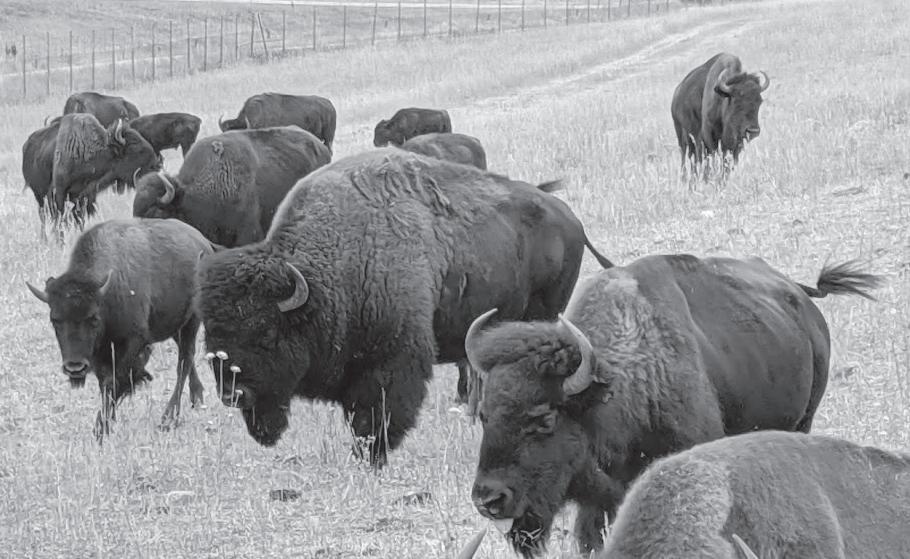
ADAMS COUNTY DENVER ERIE STEAMBOAT SPRINGS

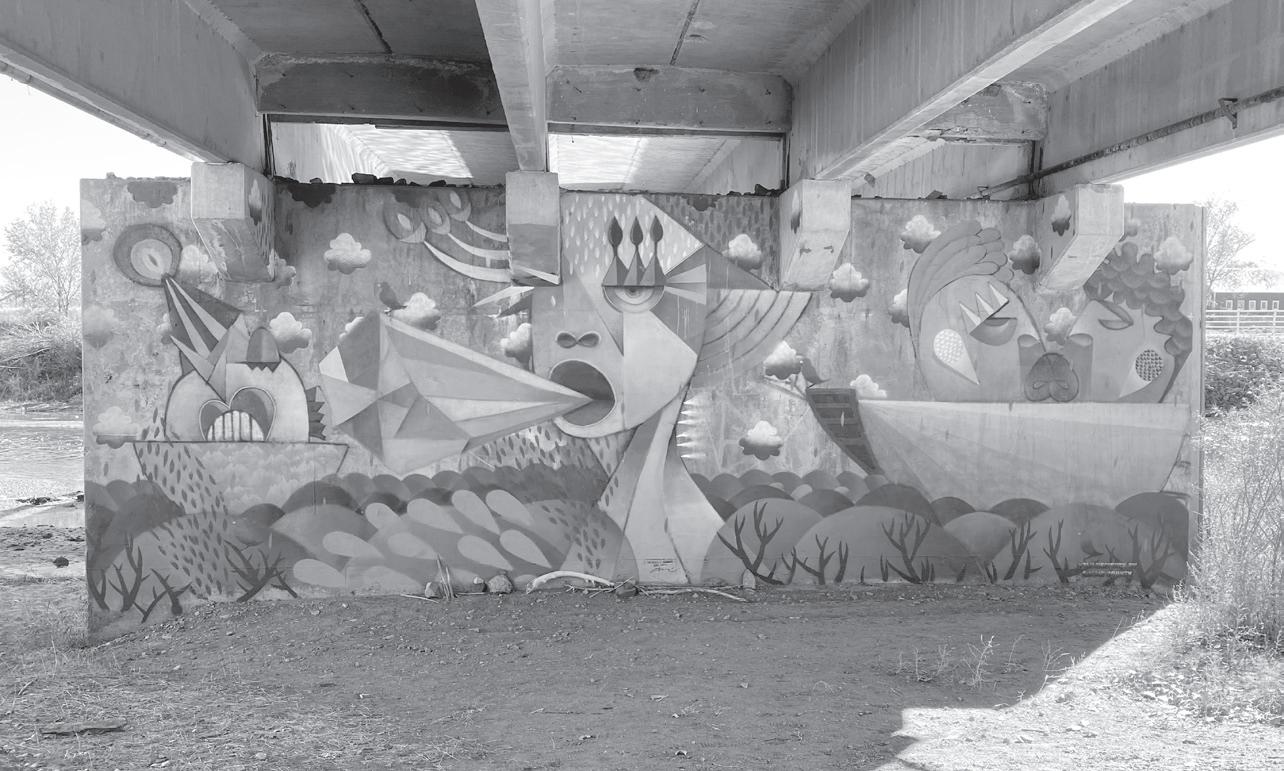
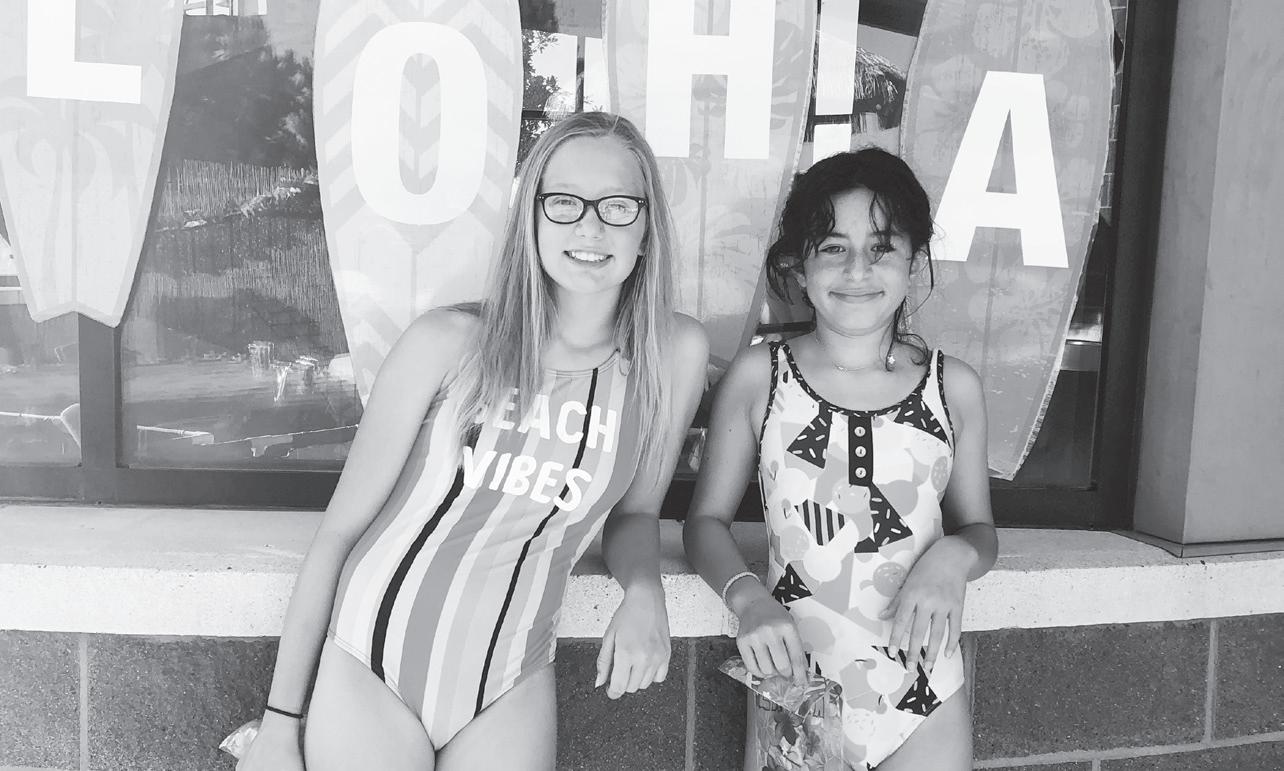
Town of Erie Aquatics Team Dives to New Depths – in Uncharted Waters
By Matt Brown and Erika Eaton, Aquatics Staff, Erie Parks and Recreation
The COVID 19 pandemic put an abrupt halt to all of our plans for
2020. Sounds of kids laughing and splashing in our pool during open swim. Gone. The excitement of parents and kids of their accomplishments in swim lessons. Gone. The controlled chaos of open swim and the inevitable sound of whistles from lifeguards asking a kid to walk for the 5th time (not exaggerating). Gone. Even the constant talk from water aerobics community clamoring for warmer water would have been preferred to the deafening silence radiating from our once thriving Community Center. As the silence filled our once busy pool and Community Center, the talk went from how excited we were to implement our new programming to staff wondering if and or/when we would see people enter our building again. The Erie Community Center was closed from March 13 to June 15 and even though our doors were closed, it did not mean we closed our business. In fact, just the opposite. Our aquatics team at the Erie Community Center used this closure to reflect on what we did well, revamp things we needed to improve on and adjust how we do business. Our Aquatics team attacked this closure on three fronts: Aquatic Operations, Programming, and Staff growth. All were approached with a singular thought of when the meet the public again we will be a better version of ourselves then when we closed.

During the time of our closure we were able to reschedule and complete two major CIP projects in April which were originally scheduled for August during our usual maintenance week shut down. We installed a new defender filtration system on our main pool. Along with the new defender filtration system, we also installed a Clear Comfort System on our hot tub which is a secondary sanitation system to allow our hot tub to run normally but with fewer chemicals needed. Our water slide also was repaired to fix leaks and the flume was waxed to allow for a smoother ride. By completing these projects in April, we able to avoid a second shut down in August. In addition to the big capital projects, came the prevalent yearly tasks which was a great way to keep staff working. We resealed and painted the pool deck surface to add more grip so to keep our guests from slipping. We drained the pool and power washed the plaster of the pool and hot tub to get oils and mineral deposits off. We deep cleaned all of our pool tiles, scraping off calcium deposits and removing scum line stains helping to make our pool look cleaner and newer then when we shut down. New pool equipment was ordered to allow for us to have enough for all swimmers to receive their own swim bag full of equipment that can be sanitized after each use.
With the challenges of trying to follow ever changing public health orders, we only found solutions on how to reorganize our programming to keep our participants safe. Private swim lessons, water aerobics, Lifeguard Training classes and trainings were all taught with social distancing, proper PPE, and in accordance with Red Cross guidelines. We placed a parent/guardian in the water assisting the swim lesson participant while the instructor taught from the deck with a mask on. For lifeguard training and lifeguarding certification classes, we ordered a full life-size rescue mannequin so lifeguards were able to make rescues instead of making rescues on one another. We also provided the opportunity for participants to bring in a family member to practice saves on. We switched from relying on our own staff to conduct our programs to allowing outside agencies to reserve lane space for use of the pool. Synchronized swim teams have rented a total of 100+ hours
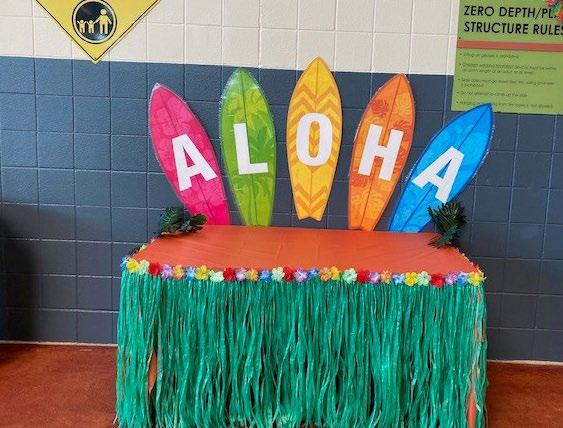

of use during our slower lap swim times. Aloha Birthday parties were a joint venture with our Guest Service team to use our underutilized pool and the deck/outside spray garden. Throughout this process, we have seen amazing staff growth. Bright eyed staff always seeing the glass half full and looking for ways they can assist or offering feedback and suggestions. Full time staff created and updated COVID 19 protocols to allow for people to come in and use the facility in a safe manner. We conducted virtual trainings to help staff feel connected to each other and to keep up to date on the skills necessary for their jobs. Full time and part time staff were encouraged to cross train and work with other departments in the Community Center and within the Town. For example, lifeguards assisted our Active Adults staff serve their weekly lunches successfully via a drive up service and also participated in special events. The moral of our story is that no matter what, we kept pushing forward with a single focus in mind: we will reopen again, and when we do, we will be better than before and ready to serve the public. As our facility was once again filled with laughter and fun, our staff can reflect and be proud of what we accomplished. Is our story unique? Probably not, but we are able to look back with pride knowing we are capable of doing great things during unprecedented times.
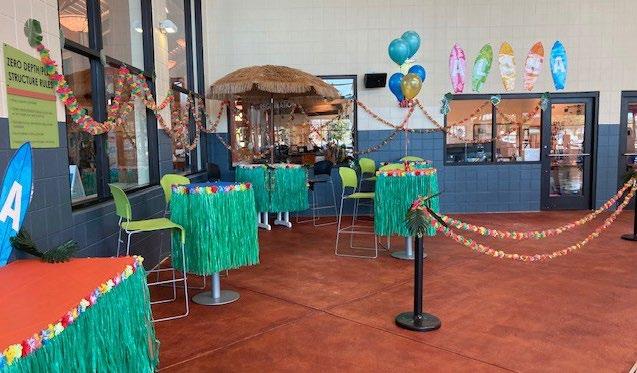
Adapting Spaces in Steamboat Springs
By Alexis Wolf, Recreation Manager, Dmitry Chase, Howelsen Ice Complex Supervisor, and Nick Carelli, Adult Sports Supervisor, City of Steamboat Springs

We were five months into the COVID-19 pandemic when the Director of Parks & Recreation popped her head into my office. “I just spoke with the guys next door, and they were talking about miniature outdoor ice-skating
rinks. Run with it.” She left just as quick, leaving me open mouthed and baffled. Four months later, on December 8th, 2020, two new, free to the public, outdoor Community Ice Rinks opened, and it never would have happened without COVID.
This was an idea that had been tossed around by rink staff for years, and by itself isn’t anything revolutionary. Many towns have these outdoor rinks, in fact, many people have them in their back yards. New and different this year was having a specific mandate due to COVID for additional, low or no cost, outdoor recreation opportunities. The indoor Howelsen Ice Complex was closed in March of 2020 to become the Emergency Operation Center and was transformed into a medical facility – luckily never to be used in that way. The rink was reopened in August 2020 for limited practices and public access, and restrictions keep it operational but with very limited capacity, even now. We wanted to get ice available outside, and it took an extraordinary number of people with innovative ideas and a willingness to work collectively to make it happen. The primary hurdle at the beginning was to determine a funding source. How does one purchase, install, and maintain outdoor ice rinks without any money? Talk to your people. You know who they are. They are the ones who are there every day, the ones who actually read the newsletter and may even respond, the ones who truly care about the services you provide. Friendly conversations over the summer continuously exposed those who were willing to invest in solutions, so when this concept gained traction, we already had a mental list of patrons who might be willing to donate, patrons who desperately wanted to skate. Through

simple outreach, a few follow up conversations, phone calls and emails, pledges were secured to cover the entire $19,000 cost of the project, thanks in large part to the positive relationship building that had been curated over years of interactions between the rink staff and the families who frequented it. One cannot underestimate the power of positive, long term relationships. Once the funding was in place, the truly creative thinking started to happen. We needed a secure location that was close to the existing rink. We needed a flat surface that could withstand the weight of 60,000 gallons of water, along with a winter water source. We needed a way keep the ice clear of the hundreds of inches of snow that fall every year and giving the local kids a few shovels wasn’t going to cut it. Each requirement led to several more, and it became quite overwhelming. Luckily, there are some very dedicated and creative minds working for Parks & Recreation, and they love a good challenge. Our outdoor tennis courts became the chosen location. These courts are conveniently placed in the heart of Howelsen Park, smack in the center of Steamboat Springs, and are one of the few amenities that sit empty and unused each winter, collecting snow and waiting for the spring to come. That location not only had the flat surface that was required, but it also had lights, fencing, and electricity already available. Parking was not an obstacle, and it allowed this new amenity to be created without impacting existing programs or facilities. It also alleviated apprehension from the Parks crew, concerned about negative impacts to the grass fields had we placed them there instead.
The rink staff then worked closely with the maintenance department to create new machinery. While the rinks arrived with a manual “resurfacer”, it wasn’t going to be adequate for these purposes, and would require access to water that didn’t exist on site. There was no way that a Zamboni could get onto the surface of the ice, and adequate snow removal remained an obstacle. By using a large water tank in the bed of a Toolcat, adding a small, removable snowblower to the front, and attaching the resurfacer to the back, the “Delboni” was born – affectionately named after its creator. A few small ramps enable the Delboni to access the ice and allow plowing and resurfacing in a short amount of time. Shovels are always available for individuals to use as needed, of course. Ever since that cold December morning, the rinks have been available to the public, free of charge, both mornings and evenings. People of all ages can be found there daily, figure skating, playing hockey, and generally having a great time while getting some much-needed exercise and fresh air. Others like myself, who don’t consider themselves ice skaters, have rediscovered a sport from their childhood, and are having a fantastic time reconnecting with the past. The feedback that we get is overwhelmingly positive. The rinks have even been featured on Denver 9 News twice! It wasn’t easy, and luck and hard work played significant roles. Snowmaking at the nearby ski area made it difficult to create the desired ice surface. The tennis courts weren’t as flat as we thought. Had the rinks been installed in a different direction, there would have been too much of an incline to hold the water. The list goes on. Staff are still learning every day, and will make plenty of changes for next year, but the knowledge gained and the lessons learned are invaluable moving forward. While there was plenty of hope, we never expected the level of success and usage that the outdoor rinks have shown.
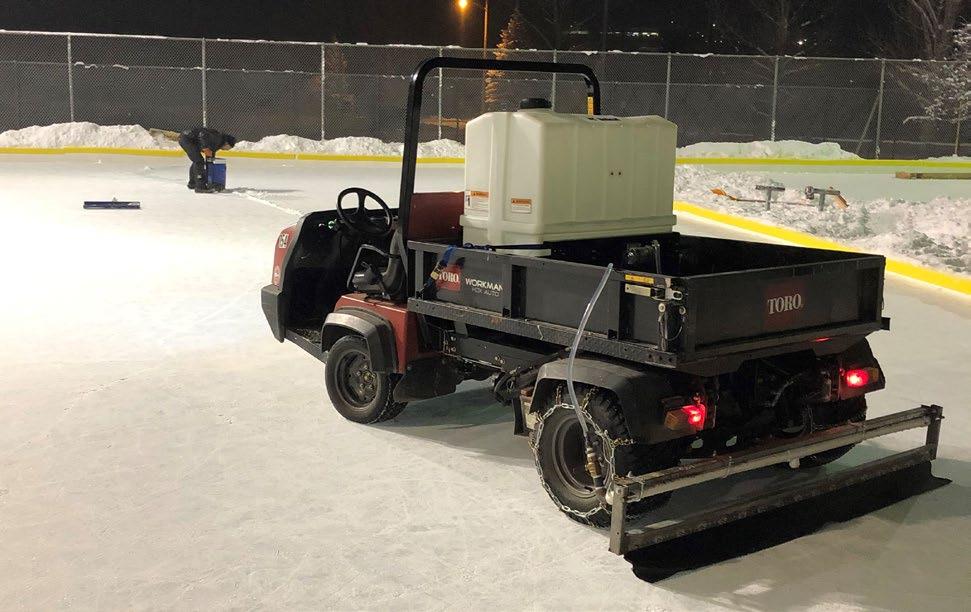
Just last week, our City Council ended their discussion asking, “How can we get more outdoor rinks next year?” and I look forward to working with our incredible team to accommodate them.
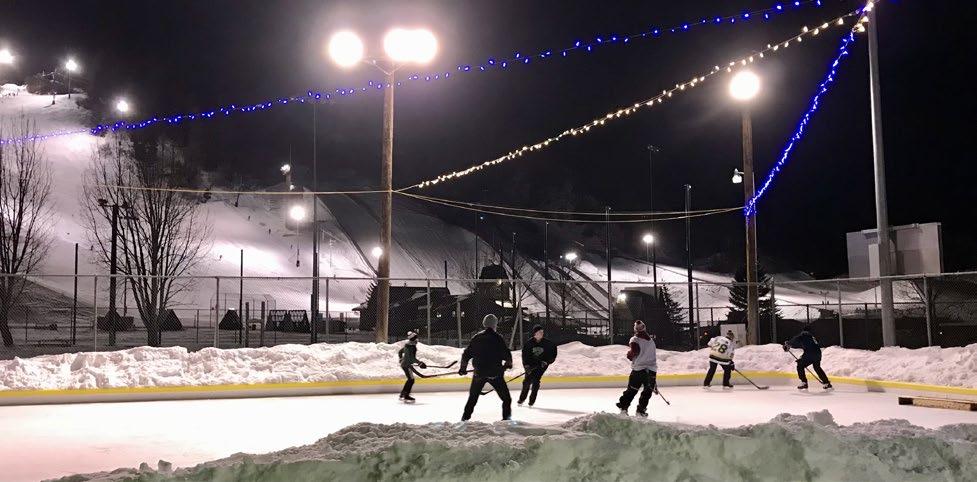
By using a large water tank in the bed of a Toolcat, adding a small, removable snowblower to the front, and attaching the resurfacer to the back, the “Delboni” was born – affectionately named after its creator.
Never Let an Opportunity Go to Waste
HOW SERVICE AND PURPOSE CAN SHINE A LIGHT OF POSITIVITY THROUGH CHALLENGING TIMES
By Charles Flinn, CPRP, Recreation Coordinator, Town of Erie Parks & Recreation
Service is a choice. Every single day of our lives are, from an abstract view, an unbroken series of choices. A specific choice that has always stuck with me is: “You can go through change or you can grow through change.” Here in Erie, we choose the latter.
When I arrived in Erie at the end of 2019, I held an all-staff meeting with the Facility Operations department where I literally and figuratively now stood at the head of. I sent a poll the week before the meeting to get a pulse of the department and folks, the results could be categorized as “not great.” The results uncovered several issues in communication, training, onboarding, management, morale, and turnover. Oh, and this meeting occurred two weeks before the global pandemic broke into the United States.
Initially, it was obvious that there were fundamental and structural issues that were both deep-rooted and would also require significant time, effort, and commitment to repair…also known as: change. Change is hard and it creates natural senses of apprehension, anxiety, and loss. By initiating a change of this scale and magnitude, it would be fair to assume that an effort to address these would encounter natural human structures of hostility and defenses. To counter this, we leaned into a push/ pull style of change leadership. We would lead from the front, communicate a detailed plan, and pulled the group up the mountain while simultaneously meeting our staff where they were, walk that journey alongside them, and push when needed. And then COVID-19 happened. Times like these remind me of my favorite quotes: “Everyone has a plan until they get punched in the face, or encounter a global pandemic.” - Mike Tyson Fast forward a few weeks to a shuttered facility and a staff of 50 looking to their new boss for answers and leadership through an event that none of us have ever experienced. The moment had arrived, unannounced and without welcome, and I was now faced with a choice: would I lead this team to go through this change, or would we grow through this change? As I huddled with my lead team, we were all in agreement that through these dark, challenging times of a pandemic an opportunity had presented itself. With such an alarming, common threat invading our lives, the staff would likely suspend their antagonisms and allow us to accelerate our massive plan that was beginning to take shape. By identifying a common enemy, we could create a natural comradery, lift the esprit de corps, and pour that energy into this project. An entire Facility Operations team that now did not have a facility
to operate was still able to coalesce together and find purpose. Prior to my arrival, the department was known as Guest Service Operations, or GSO for short. Thus, I decided to name our 5-point project GS2.O. Based upon the results of the poll, we identified five key areas that needed our help: Organization & Structure, Staff Manuals, Onboard & Training, Job Descriptions, and Values & Culture. Now that we identified a destination, it was time to get to work. While initially daunting, this project gave us the unique opportunity to re-think the entirety of our operations. By identifying the foundation of the problems provided to us from the staff, we were able to build our five pillars on top of it. This gave us the allowance to look at our department from beginning to end and we started with the most basic – what do we call ourselves? Does our organization & structure align with our overall goals, values, and expectations? Do our job descriptions match our job expectations? How long should it take to go from new hire to fully on-boarded? What are the core values for our service delivery? Initially, we had laid out a step-by-step timeline to achieve our goals. However, we realized another pivot would be necessary as each individual point of the project interacts both individually and holistically with the other four points. As we stepped back, we recognized that we were looking at an interconnected web rather a linear projection to success. Within Facility Operations, nothing exists in an abstract manner. I have always thought that working on the Operations side can be best understood visually as a hub of the Recreation wheel. Our programs, offerings, activities, sports, classes, etc. all represent different, unique spokes of the wheel. This forced us to re-think how we onboard & train our staff – less twodimensional, linear thought and more three-dimensional, universal thought. By the end of the project, we were able to present a dynamic, modern rollout of our entire department. • We are structurally organized in a thoughtful, constructive manner. • We are able to lay out a roadmap that takes our high level customer service philosophy of P.E.A.K. [Professional,
Exceptional, Accountable,
Knowledgeable] and apply it all the way down to a granular, daily expectation. Our staff manuals are now broken down by all four letters of PEAK for each position in the department. • We now have a directly applicable onboard & training process for each new hire that matches the needs of the position broken down by each week of the process. • We now have a series of Job
Descriptions that accurately reflect the duties and expectations while also fitting within the new organization of the department. • And finally, through effective communication, effortful striving, and servant leadership, we have a culture that sets the tone every day for the entire building. Sans pandemic, I believe that we would still achieve this; albeit on a different timeline and with greater resistance. However, I now know the incredible abilities of my team while also discovering their unwavering commitment to Erie Recreation. By finding a new purpose, we have been able to grow through a year of unending change. Whether it be our town or our team, we choose to serve.

Flexibility: Answering the Call to Tackle Whatever is Thrown at You
By Casey Gray, Recreation Center Coordinator, Denver Parks & Recreation
As I prepared to start my new job in March of 2020, I received a call from my new boss. All recreation centers were closing and I should be prepared to be deployed to another city service department. Ten months, three redeployments, a two month furlough and a brand new baby girl later, I am still left wondering what a normal day at my recreation center looks like.
I was given the opportunity to experience recreation in a whole new light; from caring for the bison herd and building circhouses (durable, transportable habitats) with the mountain parks division, to learning the art of tree work with the forestry department. Somewhere in the middle I also learned how to restore historic windows, build rustic furniture and receive my CDL permit. These are life skills I never dreamed of having and now I will carry with me for many years to come. When I reflect back on the last ten months, gratitude is the best way to describe my pandemic experience. I am grateful for my health and that of my family, to have a job when so many people throughout the world are much less fortunate, and so grateful to have had the opportunity to get to know a whole new set of coworkers across many departments and facets of the city. Lastly, I am grateful for all of the people who worked tirelessly to ensure my coworkers and I had projects and tasks to keep us employed. Over the coming months, we will be focused on transitioning back safely into the recreation centers and discovering what our new normal will look like, post pandemic. Talk about a lengthy onboarding!

Madelyn Jean Gray


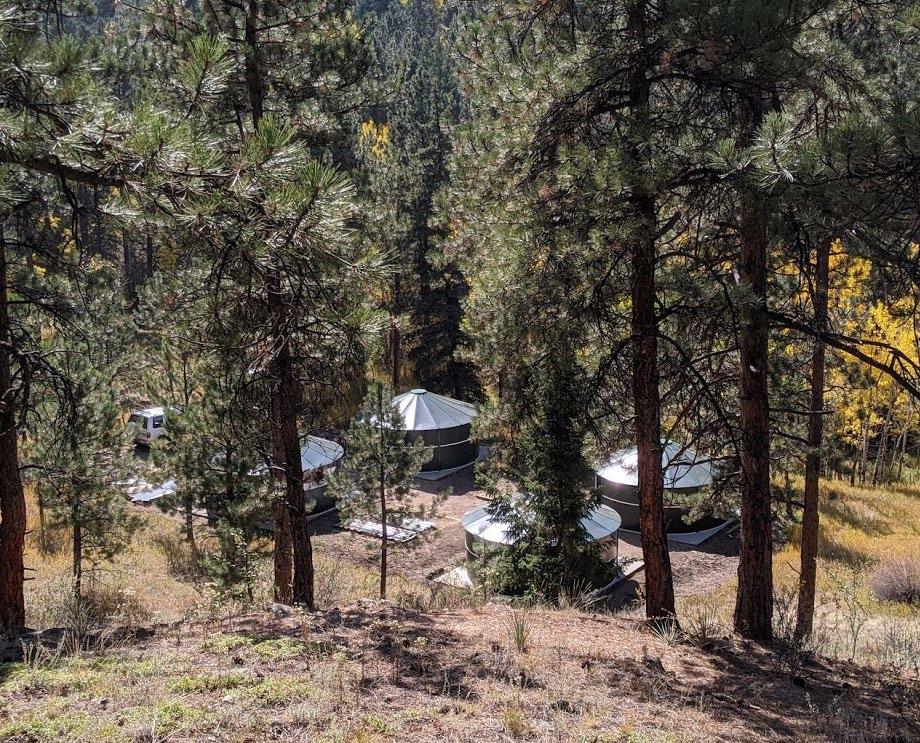

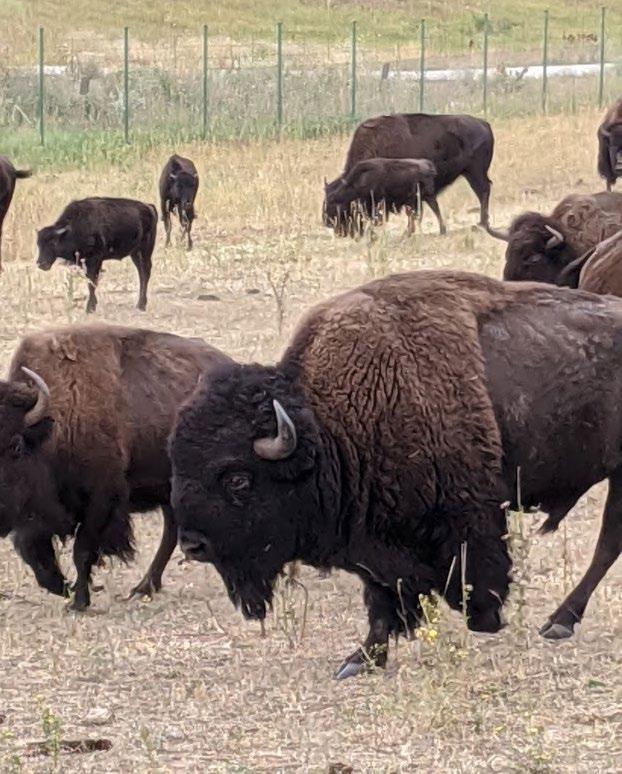
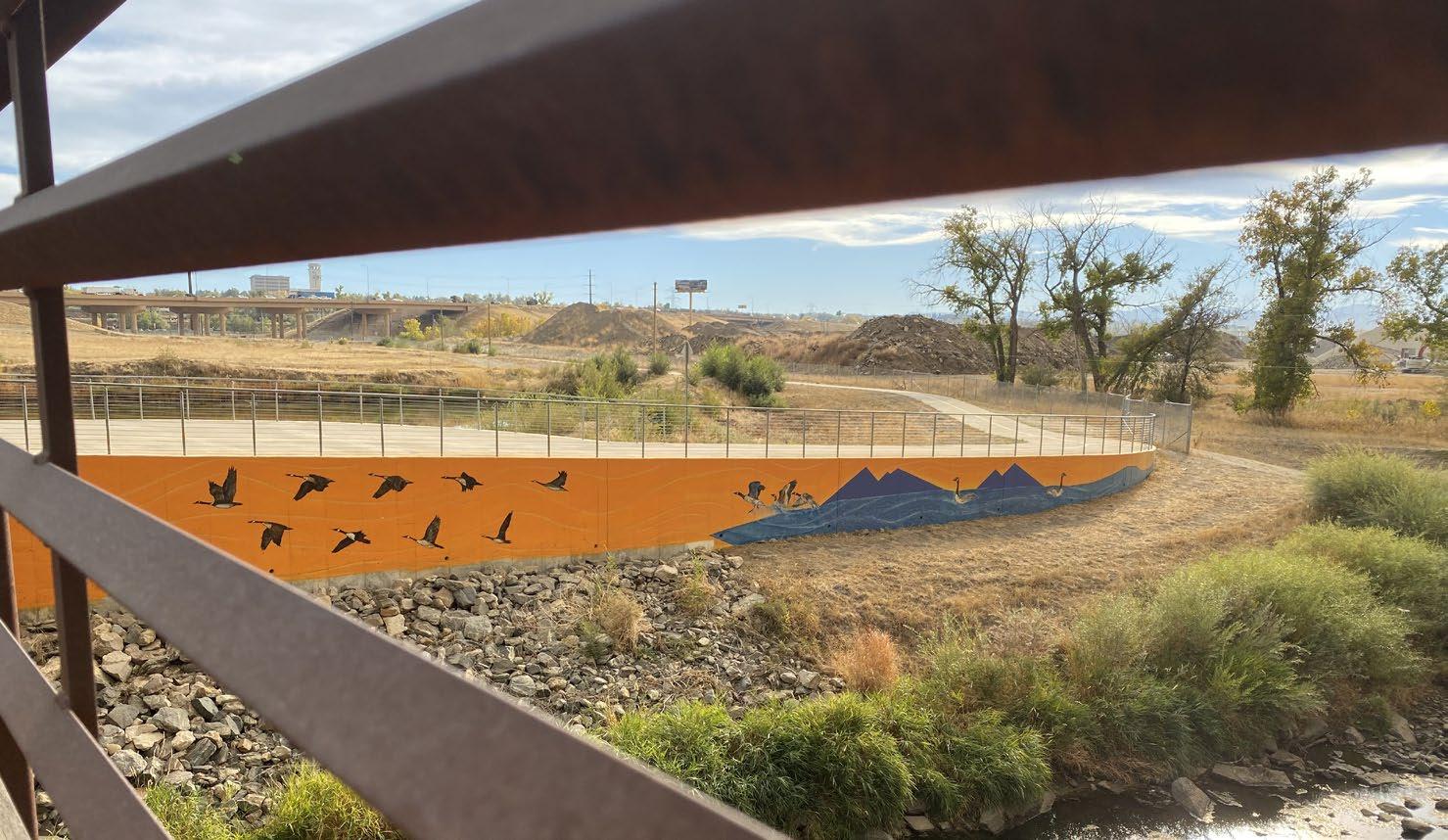
Using Public Art as a Way to Connect Residents in Adams County
In response to the COVID-19 pandemic, the Adams County Parks, Open Space & Cultural Arts Department launched two public art projects to bring hope and joy to communities, inspire residents and visitors, and fuel the local economy.
By Zoe Ocampo, Cultural Arts Liaison, Adams County Parks, Open Space & Cultural Arts
Murals for Hope
Murals for Hope is a series of exterior murals along the Clear Creek and South Platte River Trail systems in Adams County. Themes for each installation were inspired by the wildlife and beauty of the parks, trails, and open space properties throughout Adams County. They commissioned six local artists to install large murals along the trails from July through December 2020. Mural artists included:
Jay Jaramillo and Jerry
Jaramillo, Clear Creek Trail, 64th Avenue Trailhead AJ Davis (Project Street Gold), Clear Creek Trail, Clear Creek / South Platte Confluence
Johanna Gentry, South Platte River Trail, Clear Creek / South Platte Confluence Anthony Garcia (Birdseed Collective), South Platte River Trail, 120th Street Entrance, Riverdale Regional Park Michael Gadlin, South Platte River Trail, 124th Avenue Underpass, Riverdale Regional Park

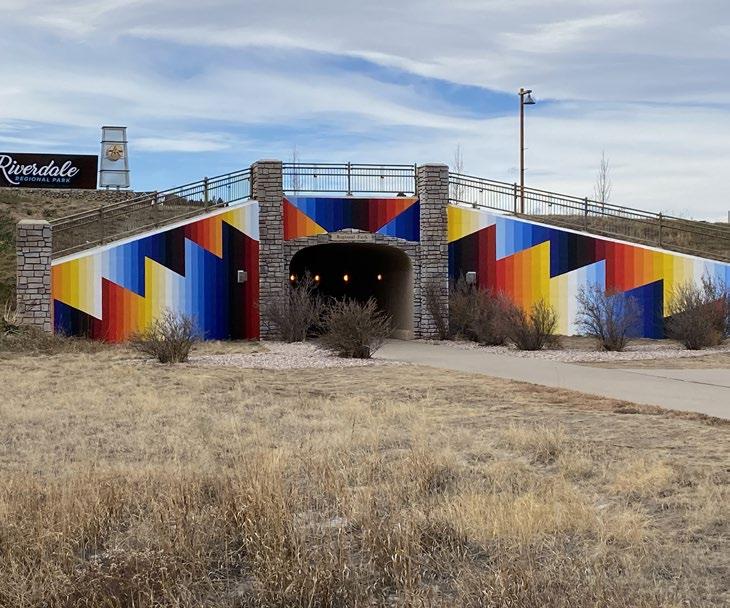
Artist: Anthony Garcia

Artists: Jay Jaramillo & Jerry Jaramillo Artist: MIchael Gadlin


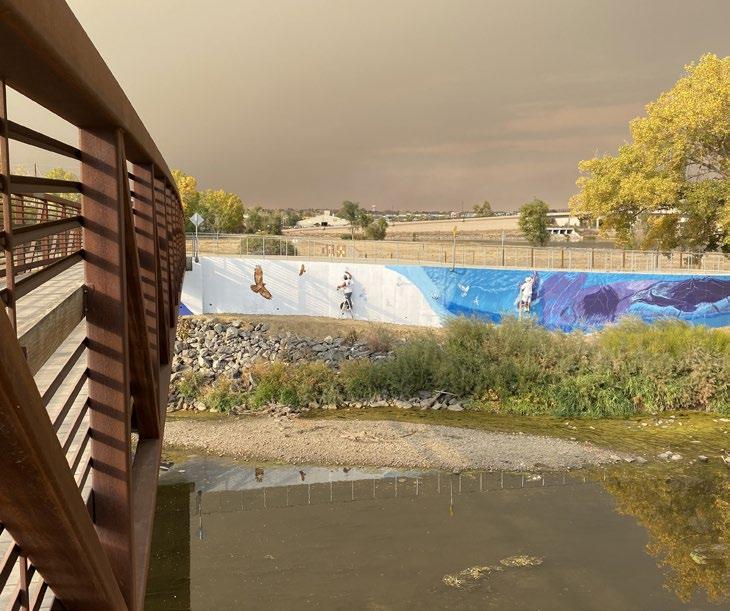
Artists: Jay Jaramillo & Jerry Jaramillo
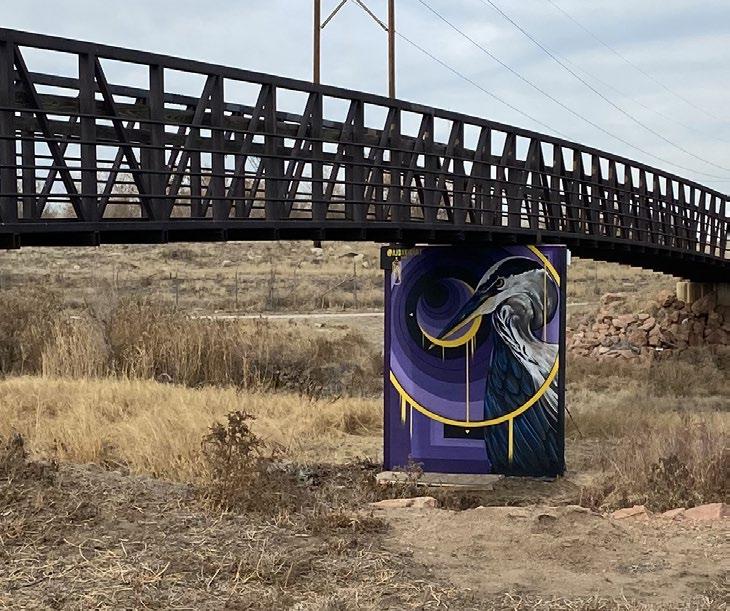

Artist: Faye Braaten (a.k.a. Chainsaw Mama) Artist: Mark Mahorney Artist: Bongo Love



Artist: Faye Braaten (a.k.a. Chainsaw Mama) Artist: Matt Ounsworth

Wood Carving Commissions
In addition to Murals for Hope, we commissioned a series of ten wood carvings between 120th Avenue and Willow Bay along the South Platte River Trail in Riverdale Regional Park. Chainsaw artists included: Faye Braaten (a.k.a. Chainsaw Mama), Mark Mahorney, Bongo Love, and Matt Ounsworth. The wood carvings were also inspired by the natural beauty of Riverdale Regional Park. With subjects like great blue heron, eagles, owls, and flora and fauna. There might even be a sasquatch hiding somewhere along the trails!
Art with a Purpose
Through these two projects we had several goals: to inject dollars directly into our local Adams County and Colorado economies to support working artists; to activate our trails and parks with live art installations; to inspire residents to get outside, be safe, socially distanced, and still part of their communities; and to bring hope and joy through color, beauty and stories. When we first reached out to the artists, we received overwhelming excitement about the project. It was during the quarantine when everyone was home, uncertain of what was to come. We specifically sought out artists with ties to Adams County, and everyone reacted the same way – they wanted to paint and focus on creating something beautiful where they live. Never before had people focused so much on home and it was an opportunity to do just that. Learn more at www.adcogov.org/arts-culture-current-projects




